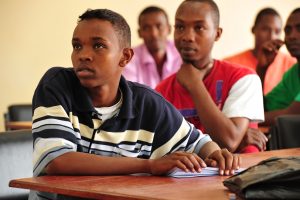Adaptive Management: Nice Idea, How Do You Do It?
This blog post originally appeared on the Education in Crisis & Conflict Network's website on May 10, 2016.
Recent Evidence from the Field
Many practitioners struggle with program design and management of education projects in places where the threat of conflict is ever-present, where militias, gangs, and even just bullies are right around the corner. Recent reports from the field provide insight and tools on adaptive management and feedback loops, the core of USAID’s Collaborating, Learning and Adapting (CLA) approach.
The Asia Foundation: Strategic Testing
For several decades, The Asia Foundation has led the field in developing programs that emphasize experimentation, building strong relationships and deep knowledge, and maintaining tight feedback loops between learning and action. Their recent paper, Strategic Testing: An Innovative Approach to Monitoring Highly Flexible Aid Programs, describes the application of a system to track theories of change (ToC) that address complex development problems through a highly iterative, adaptive approach. The strategic testing (ST) approach involves the following:
- The program team and stakeholders articulate their collective understanding of the problem the program aims to address, the key factors perpetuating the problem, the binding constraints to change, and the team’s best supposition about the most likely path to change. They recognize that the ToC is likely incomplete and will evolve over time as they build relationships, gather information, experiment, and most importantly, reflect on what is working and what is not.
- Approximately 4 months after developing the initial ToC, the team conducts its first ST exercise, which is repeated approximately every 3 or 4 months. This exercise involves the following steps:
- Review what has happened since the start of the program, key changes affecting outcomes, and what they have learned;
- Critically assess this information to determine what they need to do to strengthen their ToC and adjust the program (this process is guided by “ST Review Guiding Questions”);
- Refine or adjust, as necessary, both the program outcomes as well as the strategies and activities to achieve these, dropping those activities that have proven ineffective and adding new strategies to address dimensions not well understood;
- Document how and why the ToC has been revised, identifying related programmatic, operational, or budgetary implications (using an “Adjustment to the Theory of Change” form).
The Asia Foundation has completed four cycles of ST as of August 2015; the approach is used by 16 programs across 10 countries working on development problems that range from reforming energy policy in Bangladesh to improving urban services in Phnom Penh. It is proving to be an effective system for program teams to embrace a flexible program approach and make strategic adjustments that increase the likelihood of program impact.
Liberia: Realtime M&E for Adaptive Youth Employment Programming
Our Youth, Livelihoods and Feedback Loops blog published in January reported on Mercy Corps’ innovative PROSPECTS Youth Livelihoods project in Liberia, where M&E seeks not only to prove project effectiveness, but to improve ongoing strategies and activities. Rather than waiting until the program is complete before doing an impact evaluation, PROSPECTS captures early outcomes using a dashboard to track impacts. Based on the analysis of that feedback, project staff incorporate the insights of front-line workers and form action plans on what needs to be done differently going forward, including setting new targets. Prospects Practice Paper No.2 describes this system in detail, including the tools and formats used for gathering, presenting, analyzing and utilizing the feedback. Stay tuned as PROSPECTS continues to both innovate and evaluate for better outcomes in the complex, changing environment of youth livelihoods in Liberia.
Do you have stories, experience, and grounded research related to adaptive management and the CLA approach for education in crisis and conflict-affected contexts to share? Join the conversation on the Education in Crisis & Conflict Network website.




